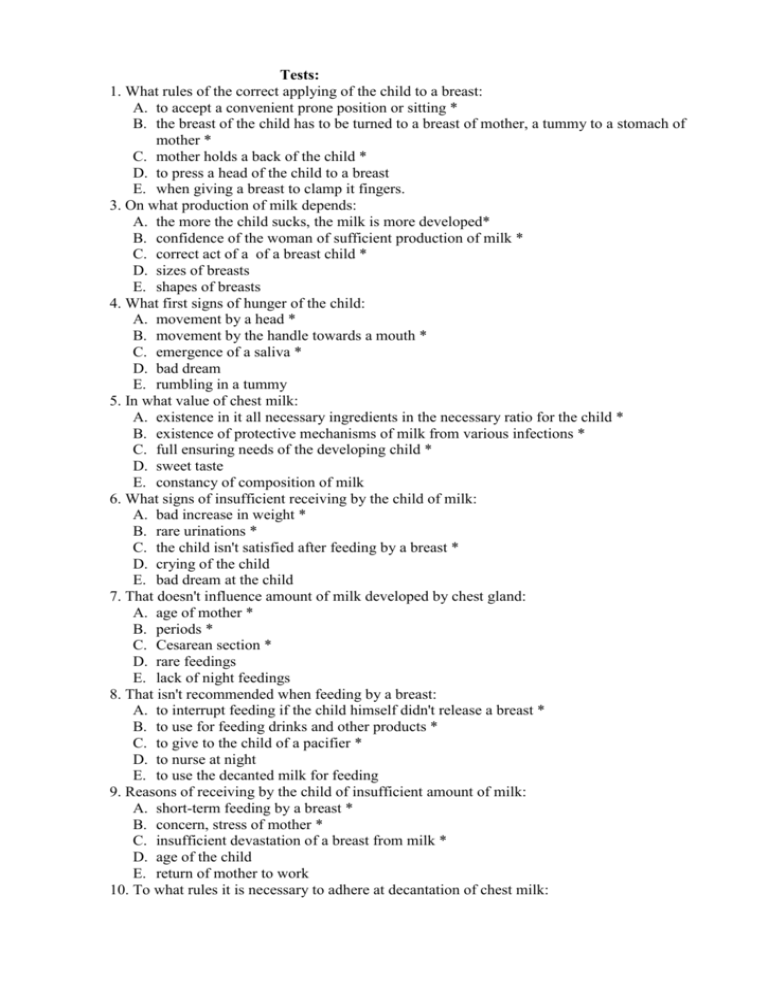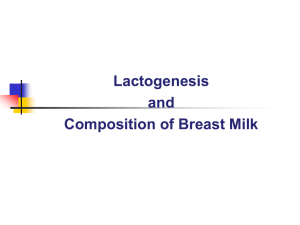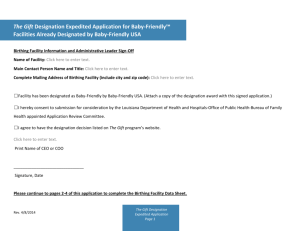Tests: 1. What rules of the correct applying of the child to a breast: to
advertisement

Tests: 1. What rules of the correct applying of the child to a breast: A. to accept a convenient prone position or sitting * B. the breast of the child has to be turned to a breast of mother, a tummy to a stomach of mother * C. mother holds a back of the child * D. to press a head of the child to a breast E. when giving a breast to clamp it fingers. 3. On what production of milk depends: A. the more the child sucks, the milk is more developed* B. confidence of the woman of sufficient production of milk * C. correct act of a of a breast child * D. sizes of breasts E. shapes of breasts 4. What first signs of hunger of the child: A. movement by a head * B. movement by the handle towards a mouth * C. emergence of a saliva * D. bad dream E. rumbling in a tummy 5. In what value of chest milk: A. existence in it all necessary ingredients in the necessary ratio for the child * B. existence of protective mechanisms of milk from various infections * C. full ensuring needs of the developing child * D. sweet taste E. constancy of composition of milk 6. What signs of insufficient receiving by the child of milk: A. bad increase in weight * B. rare urinations * C. the child isn't satisfied after feeding by a breast * D. crying of the child E. bad dream at the child 7. That doesn't influence amount of milk developed by chest gland: A. age of mother * B. periods * C. Cesarean section * D. rare feedings E. lack of night feedings 8. That isn't recommended when feeding by a breast: A. to interrupt feeding if the child himself didn't release a breast * B. to use for feeding drinks and other products * C. to give to the child of a pacifier * D. to nurse at night E. to use the decanted milk for feeding 9. Reasons of receiving by the child of insufficient amount of milk: A. short-term feeding by a breast * B. concern, stress of mother * C. insufficient devastation of a breast from milk * D. age of the child E. return of mother to work 10. To what rules it is necessary to adhere at decantation of chest milk: A. to arrange big and a forefinger opposite the friend – the friend in the field of an areola, other fingers support a breast * B. big and a forefinger to squeeze a breast site behind a nipple to press and release * C. movements of fingers have to be sliding on skin D. it is necessary to press on nipples and to extend their milk E. to decant each breast less than 3 minutes 11. What possible consequences at the wrong applying to a breast: A. "suction" of a nipple and subsequent pain * B. grinding of a nipple and formation of cracks * C. insufficient receiving by the child of milk * D. concern and crying of the child E. refusal of the child of feedings 12. For receiving by the child of the greatest advantage of chest feeding and effective contraceptive protection for mother it is recommended: A. to begin chest feeding as soon as possible after the delivery * B. to feed according to the first requirement of the child * C. to nurse only in the first 4-6 months * D. to allow mother differing a good state of health to nurse E. to feed in the afternoon in 3 hours and isn't more often 13.The woman, the third day after birth. The bottom of the uterus at the level of the navel, the uterus is soft, painless, lochia scanty. Meet the diagnostic criteria: A. lohiomethre * B. metroendometritis B. peritonitis G. placental polyp D. parametritis 14. Puerperant the 10th day after birth. The nature of lochia: A. mucous B. seromucous * B. spotting G. blood-serous D. blood-mucous 15. Post-partum day 7. Fundal height: A 3 p / n above the womb * B. at the top of the womb B. at the navel G. midway between the vagina and the umbilicus D. 2 p / p below the navel 16. Prevention from puerperal infection is achieved by: A. oral care * B. washing your hands * B. a change of clothes * G. refraining from a hygienic shower D. failure of breast-feeding 17. In puerperal on the third day there was a chair. That can be assigned: A cleansing enema * B. saline laxative * B. oil enema G. senna extract D. prunes 18. Duration of post-partum period: A. 42 days * B. 6-8 weeks * B. 4 weeks G. 12:00 D. 10 days 19. Inspection of puerperal does not include: A general assessment of the state of B. palpation of the abdomen to examine the uterus B. assessment of smell, color and quantity of lochia G. IUD * D. determining the integrity of the walls of the uterus * 20. For lactostasis characterized by: A uniform breast engorgement * B. moderate breast engorgement B. body temperature of 40 degrees, chills G. free secession of milk * D. an increasein blood pressure








